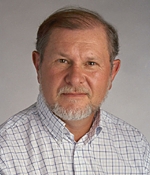 |
 |
|
 |
 |
 |
 |
 |
|
 |
 |
 |
 |
 |
|
David Albertini
|
|
No Time for Silence
Scientists, journalists discuss the emerging story on environmental estrogens
David Albertini has been thinking about chemicals in the environment, and how they can disturb reproduction in animals, for a long time – “ever since I read Rachel Carson’s Silent Spring in high school,” he says. “I’m sure it even shaped my career in research.”
In June 2007, Albertini realized a long-held desire to bring scientists and journalists together to discuss the mounting evidence that Carson’s 1962 book presciently foreshadowed: Commonplace industrial chemicals, used in products from baby toys to dental sealants, can profoundly affect reproduction and early development in several species.
The symposium, “Our Chemically Modified Environment: What is Happening to Reproductive Homeostasis?” was presented through the MBL’s Frontiers in Reproduction (FIR) summer course, which Albertini co-directs. Albertini is a reproductive cell biologist from the University of Kansas Medical Center and a Whitman investigator at the MBL.
Serendipitously, the symposium coincided with the centennial of Rachel Carson’s birth. Joan Ruderman of Harvard Medical School gave an historical overview of the “environmental estrogen” problem, and she began by showing the audience copies of Carson’s applications to perform research at the MBL in 1929 and 1932. “Carson had such a strong impact on this area, long before people would listen to it,” Albertini says.
The speakers focused on “endocrine disrupters” – compounds such as the insecticide DDT and the commonly used plasticizers bisphenol A and phthalates – that mimic the action of steroid hormones, particularly estrogen and androgen, in the body. Even at very small doses, these compounds disturb the vital roles of hormones during embryonic development. Some of them affect the proliferation of breast cancer and prostate cancer cells.
“We are beginning to know a lot about some of the chemicals that act like hormones and how they profoundly affect reproductive ability,” says Pat Hunt of Washington State University, who presented her research on the deleterious effects of bisphenol A on meiosis in mice eggs. “But there are a lot more players than this,” she adds. “We are exposed to a barrage of chemicals on a daily basis and we need to know how they act in the body, and how they act in mixtures in the body.
“This is an emerging area of reproductive biology that will be critical for our survival and the survival of our species,” Hunt says. “There is an awful lot of work that needs to be done.”
Stephen Hall, a contributing writer and editor at The New York Times Magazine, spoke at the symposium, and participants in the MBL’s Science Journalism Program were in the audience, at Albertini’s invitation.
“It’s important to have science journalists work with reliable members of the scientific community to broach this subject, not in an alarmist or sensationalistic way, but in a cautious and good educational forum,” Albertini says.
“It’s time to figure out how we need to be presenting the environmental estrogen story to the public,” Hall says, emphasizing that would-be discreditors of the story must be weighed against the majority of scientific opinion.
“Those who oppose legislation to regulate estrogenic compounds say there is not enough data,” says Carlos Sonnenschein of Tufts Medical School, who was on the team that first described an endocrine disrupter, nonylphenol, in 1991. “I would ask those people, would you put your son or daughter as an experimental subject to test whether (exposure) will make him or her sterile? That is why we use surrogate (animal) models. And the results in surrogate models are loud and clear.”
“This is not simple,” Hunt says. “(The manufacture of these compounds) is a huge business that generates a lot of jobs and money. These products are everywhere.” BPA and pthalates are used in many plastic products and resins, including some toys, teething rings, plastic cups and bottles, and the liner for food and beverage cans.
San Francisco recently became the first place in the nation to ban the sale, distribution and manufacture of baby products that contain any level of bisphenol A and certain levels of phthalates. The law is modeled on a similar ban in the European Union that went into effect in 2006.
“The next generation of reproductive biologists, part of their job will be talking to reporters,” Hunt says. “They have to know how to represent themselves. The (chemical) industry has professional people to represent them. We have to become more savvy.”
For details on the scientific papers presented at this symposium, click here.
|
| |

 |
|
 |
 |
|